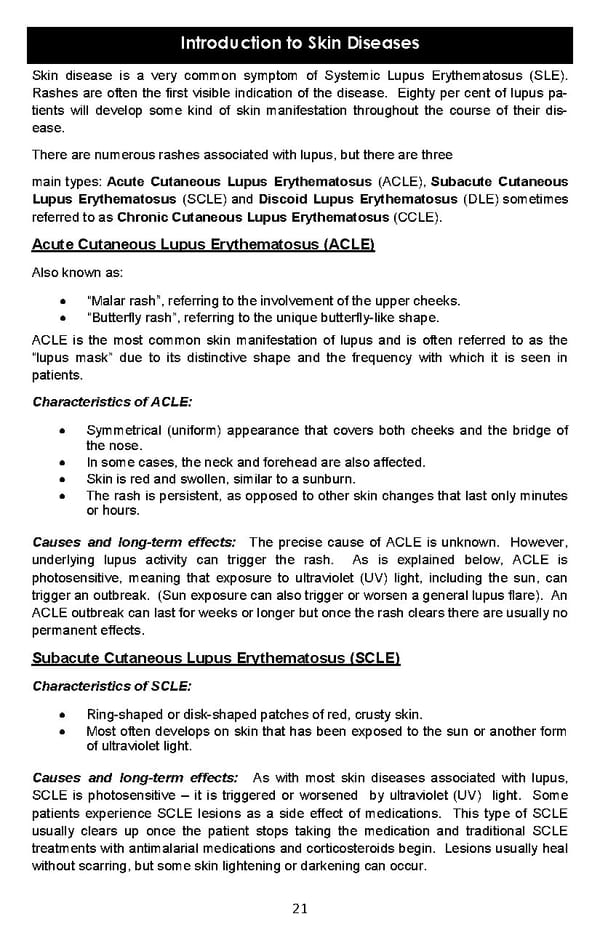Introduction to Skin Diseases Skin disease is a very common symptom of Systemic Lupus Erythematosus (SLE). Rashes are often the first visible indication of the disease. Eighty per cent of lupus pa- tients will develop some kind of skin manifestation throughout the course of their dis- ease. There are numerous rashes associated with lupus, but there are three main types: Acute Cutaneous Lupus Erythematosus (ACLE), Subacute Cutaneous Lupus Erythematosus (SCLE) and Discoid Lupus Erythematosus (DLE) sometimes referred to as Chronic Cutaneous Lupus Erythematosus (CCLE). Acute Cutaneous Lupus Erythematosus (ACLE) Also known as: • “Malar rash”, referring to the involvement of the upper cheeks. • “Butterfly rash”, referring to the unique butterfly-like shape. ACLE is the most common skin manifestation of lupus and is often referred to as the “lupus mask” due to its distinctive shape and the frequency with which it is seen in patients. Characteristics of ACLE: • Symmetrical (uniform) appearance that covers both cheeks and the bridge of the nose. • In some cases, the neck and forehead are also affected. • Skin is red and swollen, similar to a sunburn. • The rash is persistent, as opposed to other skin changes that last only minutes or hours. Causes and long-term effects: The precise cause of ACLE is unknown. However, underlying lupus activity can trigger the rash. As is explained below, ACLE is photosensitive, meaning that exposure to ultraviolet (UV) light, including the sun, can trigger an outbreak. (Sun exposure can also trigger or worsen a general lupus flare). An ACLE outbreak can last for weeks or longer but once the rash clears there are usually no permanent effects. Subacute Cutaneous Lupus Erythematosus (SCLE) Characteristics of SCLE: • Ring-shaped or disk-shaped patches of red, crusty skin. • Most often develops on skin that has been exposed to the sun or another form of ultraviolet light. Causes and long-term effects: As with most skin diseases associated with lupus, SCLE is photosensitive – it is triggered or worsened by ultraviolet (UV) light. Some patients experience SCLE lesions as a side effect of medications. This type of SCLE usually clears up once the patient stops taking the medication and traditional SCLE treatments with antimalarial medications and corticosteroids begin. Lesions usually heal without scarring, but some skin lightening or darkening can occur. 21
 Living Well With Lupus Facts Booklet Page 20 Page 22
Living Well With Lupus Facts Booklet Page 20 Page 22